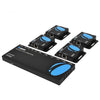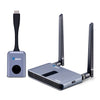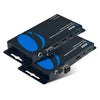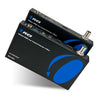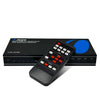How to Choose the Right HDMI Extender?

The growing demand for high-quality visuals and immersive sound brings along a challenge: extending HDMI signals across considerable distances. Whether you're envisioning a flawless home theater setup, arranging a professional conference space, or enhancing your gaming zone, the perfect HDMI extender can make all of this possible.
Today, let's explore the intricacies of this technology and discover how to choose the ideal extender for your setup. This article covers the differences between HDMI over CAT 6 or Ethernet and wireless HDMI extenders, distance requirements, and other crucial considerations necessary for selecting the right HDMI extender.
What is an HDMI Extender and How Does It Work?
Before diving into choosing the perfect HDMI extender, let's understand what it does.
HDMI extenders are the unsung heroes in the realm of modern audio-visual setups, quietly resolving a persistent challenge: the limited transmission range of standard HDMI cables. They are purpose-built devices designed to overcome the constraints of these cables, ensuring the seamless transmission of high-definition audio and video signals over farther distances.
In simpler terms, an HDMI extender is a device designed to extend audio and video signals over longer distances than standard HDMI cables allow. To further understand how HDMI extenders work, we have to learn about its components.
Typically, they consist of two primary components: the HDMI transmitter and receiver.
Transmitter: This component connects with the source device and captures audio and video signals, converting them into a digital format suitable for transmission.

Receiver: Situated near the display unit, the receiver decodes the transmitted signals, ensuring high-quality playback of the audio and video content on the display device.

This pairing of transmitter and receiver ensures that the audio-visual content retains its integrity throughout the transmission process. Whether through physical cables like CAT 5e/6/7 (known as HDMI extenders over CAT 6 or HDMI over Ethernet) or wirelessly using various wireless technologies, HDMI extenders play a vital role in delivering a seamless and immersive audio-visual experience. They eliminate the compromise between quality and distance, enabling users to configure their setups with greater flexibility and without sacrificing signal fidelity.
Why Do I Need an HDMI Extender?
HDMI extenders are crucial in modern audio-visual setups, resolving distance limitations imposed by standard HDMI cables. They cater to diverse environments like home entertainment systems, corporate boardrooms, and gaming setups.
For example, in home entertainment, HDMI extenders enable signal transmission from media sources like Blu-ray players or gaming consoles to distant display devices without compromising quality. If you have a media closet where you place all your media devices, you will need an HDMI Extender to take the signal from the closet to your TV or multiple TVs throughout your home.

Furthermore, HDMI extenders are indispensable in gaming setups, preserving high-quality graphics and audio despite physical distance. By surpassing the limitations of traditional HDMI cables, these devices ensure flawless audio-visual transmission in scenarios requiring reliable and extended signal connectivity.
What HDMI Extender Do I Need?
To identify the right HDMI extender for your needs, a detailed assessment of your audio-visual arrangement is essential. To help you choose the best HDMI Extender for your setup, we have created a 4 step guide. These are the things that you would need to consider when choosing the right extender for your setup.
Step 1: What’s the distance between your devices?
Assessing the distance between your source and display devices is a pivotal step in determining the required range of the HDMI extender. Consider the physical layout of your space, potential obstacles, and the flexibility needed for cable length or wireless reach. With the distance in mind, you can select an extender that can work in that range.
Step 2: What’s your required resolution?
Evaluate your desired resolution needs to ensure optimal audio-visual clarity. Identify the maximum resolution and refresh rate and other specifications required by your display and source devices. For instance, if you aim for 4K@60Hz HDR video, you will need an HDMI Extender that supports these formats. This ensures seamless transmission of high-quality content without compromising visual integrity or quality.
Step 3: How do you want to transmit signals?
The transmission mode you choose significantly impacts the performance and adaptability of your HDMI extender. This is the mode through which your signals will be transmitted from the source to a remote location. Let's explore the options in more detail:
Standard CAT Cables: Employing CAT 5e/6/7 cables offers a dependable and cost-effective solution for transmitting HDMI signals. This method, known as HDMI extender over CAT 6 or HDMI over Ethernet, is particularly suitable for scenarios where wired connections are feasible and convenient. HDBaseT technology further revolutionizes signal transmission by consolidating video, audio, and control signals into a single CAT cable. You may want to choose an HDBaseT extender if you are looking for an option that provides more features and reach.
Wireless HDMI Extenders: Offering unparalleled flexibility in device placement, wireless HDMI extenders eliminate the constraints imposed by physical cables. However, while wireless setups are convenient, it's crucial to consider potential interference from other devices operating within the same frequency range, which may impact signal quality and reliability.
Fiber Optic: In scenarios demanding extended distances and high data rates, fiber optic HDMI extenders present a robust and interference-resistant solution. These extenders leverage fiber optic technology to transmit signals effectively over extensive distances, making them ideal for environments where even CAT cables might encounter limitations or signal degradation.
Step 4: Do you require any special features?
Elevate your audio-visual experience by considering additional features that align with your specific requirements such as:
ARC/eARC: Audio Return Channel (ARC) and enhanced Audio Return Channel (eARC) features enable a streamlined audio experience by allowing audio signals to travel from the display to the sound system. This functionality proves especially beneficial in setups where the sound device(usually an AVR) is placed further from the display.
LAN Connectivity: HDMI extenders equipped with LAN ports extend their functionality beyond mere signal transmission. These ports facilitate internet connectivity, enabling smart device integration or facilitating firmware updates. This is essential if you have a smart TV or a streaming media device that requires internet connectivity.
Bi-directional IR: The inclusion of bi-directional Infrared (IR) capabilities empowers users with remote device control. This feature enables the seamless operation of various connected devices from any location, adding convenience and ease of use to the audio-visual setup. Users can effortlessly manage multiple devices, enhancing the overall user experience.
KVM Functionality: Keyboard, Video, Mouse (KVM) functionality in HDMI extenders enables a computer/laptop control over the same connection. This functionality proves particularly advantageous in scenarios where a computer or laptop needs management remotely. It allows for efficient device control and ensures ease of access, perfect for home office or educational setups.
RS-232 Support: HDMI extenders equipped with RS-232 support offer an advanced communication interface for integration with other systems. This feature allows for seamless coordination and control through PCs or other RS-232 devices, ensuring compatibility and enhancing the extender's capability to integrate into sophisticated audio-visual environments.
Audio Extraction: This feature involves separating audio signals from the input source to redirect them to a separate audio system, enhancing sound quality and the overall viewing experience. HDMI extenders frequently include Optical (S/PDIF) and Auxiliary (Aux) ports to facilitate this process. Optical (S/PDIF) transmits digital audio signals via fiber optic cables, ensuring high-quality sound transmission. Meanwhile, Aux utilizes a 3.5mm jack to transmit analog audio, perfect for connecting to speakers or audio systems to produce clear sound output.
With these questions in mind, you can then decide whether you need a wireless HDMI extender that’s capable of reaching up to 20 feet with 2 outputs – or a CAT6 HDMI extender, 4K-ready. that can send signals up to 100 feet with 8 outputs.
Finally, research different HDMI extender brands and models by reading online reviews and comparing their specifications, performance, and customer feedback. It’s important to find a brand that offers extensive support and warranty for their products. This will help you make an informed decision and select a reliable HDMI extender that meets your specific requirements!
To help you get started on your journey, you can check out a wide range of HDMI extenders in our shop. OREI is a trusted brand for anything HDMI, and our HDMI extenders are definitely one of the best in the market. In our shop, you’ll find each product’s full list of features and technical specifications, as well as customer reviews and sample applications.
Need further assistance in selecting the right HDMI devices for your setups? Explore more quick and easy reads on our blog!


